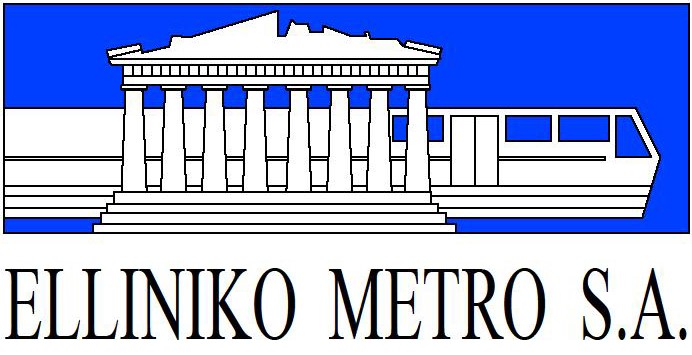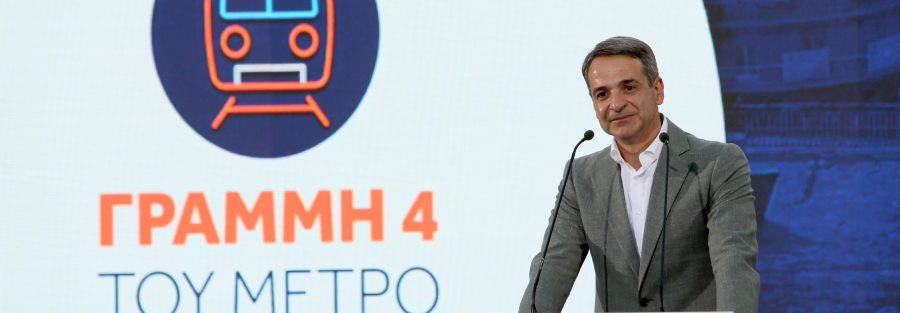On June 22nd, 2021 the contract for the initiation of the works for the construction of Athens Metro Line 4 was signed by ATTIKO METRO S.A. and “AVAX S.A. – GHELLA SpA – ALSTOM Transport S.A” Association at Alsos Veikou Theatre, in the presence of Prime Minister Kyriakos Mitsotakis and the Minister of Infrastructure and Transport Kostas Karamanlis.
The subject event was attended by the Secretary General of Infrastructures George Karayiannis, the CEO and Vice Chairman of the BoD of ATTIKO METRO S.A. Mr. Nikolaos Kouretas, as well as the AVAX Group of Companies CEO, Mr. Konstantinos Mitzalis.
Mr. Karamanlis stressed that although the Government of Nea Dimokratia inherited a Project that had been blocked and had been faced with numerous and complex problems, it focused on unblocking same, the objective being to put the subject project back on track after over 15 years.
Indeed, in December 2019, the procedure for reviewing the sub-envelopes that included the Back-up documentation for participation in the Tender and the Technical Offer resumed. Further tp recent appeals, the argument of ATTIKO METRO S.A. presented before the State Council has been proven right and, thus, financial offers were unsealed and the awarding of the Project was achieved.
At the same time, all legal issues that were raised about the awarding of the Preliminary Works were resolved. The relevant contract was signed at the end of March.
Preliminary Works include the relocation of Public Utility Organization (PUO) networks in all areas where Metro stations and shafts shall be constructed, traffic studies and diversions. The relevant procedures have already commenced and the first worksites shall be installed in summer 2021.
All the above actions were implemented within a 23-month period, in times of COVID-19 pandemic, as stressed by Mr. Karamanlis who extended his thanks to ATTIKO METRO S.A. management and employees.
The truth about EXARCHIA Station
The Minister of Infrastructures and Transport also gave responses to questions about the station to be constructed in the area of Exarchia.
First of all, the government of Nea Dimokratia has not changed the design of the station; instead, in line with the design of the government of SYRIZA, Exarchia Station was situated in Exarchia square, right from the beginning.
Secondly, as repeated by Mr. Karamanlis: “For us, there is no neighborhood in Athens that shall be hidden away and surely there are no no-go areas”.
Thirdly, Mr. Karamanlis stressed that in the past and in other areas reactions have emerged; as a result, no metro line serves these very areas, whose residents now have regretted it. The Minister of Infrastructures and Transport assured every right-thinking citizen that he will not let this happen to any other neighborhood in the city.
“The design/planning of Line 4 is a given fact. It is the one we inherited from the previous government and rest assured that this is exactly the way we will proceed as far as the implementation of the project is concerned. The Prime Minister himself has instructed us to proceed as scheduled, ignoring any political cost”, as clarified by Mr. Karamanlis who pointed out that:
“The Athens Metro is resuming. Nowadays, already more than half of the population of Attica region and 70% of the workforce have a direct access to the fixed track modes of transport. Line 4, along with the remaining scheduled projects – such as the extension to Piraeus which is under completion, or the extensions to Western Attica and to the Southern Suburbs which are under preparation – changes the image of the city. Athens Metro goes further to bring us closer”.
The Minister of Infrastructures and Transport also made the following comment:
“This project constitutes another opportunity for us to contemplate the benefits for our country being a member of the European Union for the last 40 years.
Let me give you just one figure: 180 billion Euros. This is the amount estimated to have flown in the Greek State from the Structural Funds of the European Union, i.e. almost an entire GDP, money used to actually construct and commission thousands of small and major projects throughout Greece.
Let us think through, then, how Greece would look like today if it had not joined the European Union, as well as how –a few years back- we risked being marginalized by Europe”.
On his side, Mr. George Karagiannis, Secretary General of Infrastructures, pointed out the following:
Through Line 4, various areas “escape transport isolation”, the value of various properties increases, people come closer in a rapid and safe way, with the minimum possible environmental impact. The largest public infrastructure project currently implemented in Europe whose budget amounts to 1.2 billion Euros, is about to commence. This new project shall serve many densely populated areas in the centre of Athens, as well as significant buildings and facilities, such as the National Technical University, the University Campus, the National Archaeological Museum, the Ministry of Culture, the Law School and Benaki Museum. It actually provides the possibility to more than 300,000 of our fellow citizens to leave their cars and decongest the city streets, to improve the environmental footprint of transportation and the quality of our life, in total”.
Mr. Kouretas, having explained in brief the progress of the Project, stressed that: “This major project shall have many environmental, development, social and cultural benefits. Various innovations as regards trains, materials and systems make Line 4 one of the most modern and advanced Metro systems worldwide”.
Mr. Mitzalis made the following statement: “Our proven experience in similar projects constitutes a guarantee for the flawless completion and at the same time set an even higher standard in terms of construction. A standard that we promise to exceed in the framework of this very demanding and complex project, the construction of Line 4”.
The technical details of the Project
The first section of Metro Line 4 “Alsos Veikou – Goudi” has been designed to serve a numerous densely populated areas of the centre of Athens.
The construction of four new stations (EXARCHIA, AKADEMIA, KOLONAKI, EVANGELISMOS) will decongest the existing central Metro stations – and especially SYNTAGMA Station – from the ever increasing ridership demand.
Line 4 will serve many important buildings and facilities, such as Hospitals, Courts, the National Metsovio Technical University, the National Archaeological Museum, the Ministry of Culture, the Law School of the National and Kapodistrian University of Athens, Benaki Museum (building at Koumbari street), the British Council and the University Campus.
Moreover, Line 4 will be connected with the existing Metro Lines via two transfer stations (PANEPISTIMIO / AKADEMIA, EVANGELISMOS).
The Metro Line 4 will be approximately 13km long and will extend from Alsos Veikou in Galatsi up to Goudi area within the Municipalities of Athens, Galatsi, Kessariani and Zografou.
It will accomodate 15 new stations and their ventilation shafts, namely: Alsos Veikou, Galatsi, Elikonos, Kypseli, Dikastiria, Alexandras, Exarchia, Akademia, Kolonaki, Evangelismos, Kessariani, Panepistimioupoli, Zografou, Ilissia and Goudi.
Moreover, a new Operations Control Centre (OCC) will be constructed for Line 4, capable of incorporating the respective OCC for Lines 1, 2, 3 and future automatic new lines and the Tramway, as well as a new Maintenance and Repair Building of the new train vehicles to be located in an available area in Sepolia Depot.
Finally, two line forestations will be constructed before ALSOS VEIKOU Station (underneath Veikou Avenue) and past GOUDI Station (underneath Katehaki Avenue) for the new trains stabling, cleaning and maintenance activities.
Along Line 4 provision is made for the construction of nine shafts (intershafts or terminal), i.e. EYDAP, Veikou – Plyntirio – Syntirisi, Vivliothiki, Evangelismos crossover, Formionos, Near East, Dikeosynis, TBM, Katehaki and GNA shafts.
The main tunnel of the entire project will be a double track tunnel, with an inner minimum diameter of 8.48m, it will be approximately 10.144m long and it will be constructed with the use of, at least, two new Tunnel Boring Machines (TBM) (the well-known Metromouse).
The remaining sections consist of single track, variable cross section and triple track- underground tunnels, to be bored using conventional mechanical means.
The project also includes the required rolling stock: 20 automatic driverless trains, as well as all required electromechanical and railway systems for the operation of the Line.
Scope of the contract
The scope of the contract is the preparation of the Final Design and the Detailed Final Design, the construction of Civil Works, the supply, installation, testing and commissioning of the electromechanical and railway equipment, the maintenance of the project, the training of personnel and the supply of spare parts for Metro Line 4, Section A’ “Alsos Veikou – Goudi”.
Budget and duration of the project
The contractual price of the Project is approximately Euro 1.2 billion plus VAT, funded by the NSRF, and the foreseen duration for the implementation of the Project rises to 8 years.
Locations of the stations
- ALSOS VEIKOU
ALSOS VEIKOU Station is located underneath Omorfokklisias (Veikou)Avenue, at its intersection with Tralleon street, and constitutes a terminal station.
- GALATSI
GALATSI Station is located underneath Omorfokklisias (Veikou) Avenue and on its extension (Ag. GLykerias street).
- ELIKONOS
ELIKONOS Station is located at the intersection of Aghias Glykerias and Parnithos streets, underneath of Elikonos hill, in a green area – children playground.
- KYPSELI
KYPSELI Station is located at the southeast side of Kanari square, from Kypselis street up to Velvendou street.
- DIKASTIRIA
DIKASTIRIA Station is located to the west of the Courts complex, at the intersection of Evelpidon and Moustoxydi streets.
- ALEXANDRAS
ALEXANDRAS Station is located underground, diagonally of Alexandras Avenue axis, at the intersection with Moustoxydi street.
- EXARCHIA
EXARCHIA Station is located on Exarchia square, at the intersection of Stournari and Sp. Trikoupi streets.
- AKADEMIA
AKADEMIA Station is located underneath Akadimias street, between Ippokratous and Sina streets, in the area where the Athenian Trilogy Buildings are located, between the central building of the University of Athens and the Cultural Centre of the Municipality of Athens. It is a significant transfer station with a direct underground connection with PANEPISTIMIO Station of Line 2.
- KOLONAKI
KOLONAKI Station is located on Filikis Eterias square, known as Kolonaki square, at the junction of Skoufa, Patriarchou Ioakim, Kapsali, Koumbari and Kanari streets.
- EVANGELISMOS
EVANGELISMOS Station is located underneath Rizari park, parallel to Rizari street, at an angle of approximately 60o with the existing EVANGELISMOS Station of Line 3.
- KESSARIANI
KESSARIANI Station is located at Ethnikis Antistaseos Avenue, at the intersection with Vassileos Alexandrou Avenue, between Imittou and John Kennedy streets.
- PANEPISTIMIOUPOLI
PANEPISTIMIOUPOLI Station is located in the Municipality of Kessariani, north to the interior road artery in the Campus area.
- ILISSIA
ILISSIA Station is located at Ano Ilissia.
- ZOGRAFOU
ZOGRAFOU Station is constructed underneath, along C’ Orinis Taxiarchias street, with its C/C shaft on Alexandri square (also known as Gardenia square), at the intersection of G. Zografou and C’ Orinis Taxiarchias streets with Str. Alexandrou Papagou Avenue. It is constructed based on the underground boring method using conventional mechanical means.
- GOUDI
GOUDI Station is located underneath Lox. Spiliopoulou street, also occupying a part of Eleftherias square.
Benefits for the environment
As a whole, it is estimated that approximately 340,000 passengers/day will use Metro Line 4, while the use of private vehicles is expected to be reduced by approximately 53,000/day and the carbon dioxide emission is estimated to be reduced by 318 tons/day.
New technologies
The specifications for Line 4 meet new standards and integrate new technologies, since many requirements and procedures have changed based on the experience from previous projects.
In brief, certain basic points of upgrading and improvement are as follows:
- Driverless trains.
- Trains made of environmental friendly and almost fully recyclable materials, with fully-automated and smart operation systems.
- Provision to feed back to the system the energy regenerated from train braking.
- Advanced automatic control systems of all electromechanical and railway systems.
- Provisions for cyber security as regards the operation of trains and systems.
- Advanced systems related to communication and passenger service.
The construction of Line 4 inaugurates in Greece the implementation of the Building Information Model, known as BIM, an innovative platform that is promoted by the European Commission, and that constitutes a part of the reforms of the EU Recovery Fund.
It fills the gap between the designer and the entity constructing the project, contributing to significant savings as regards the final cost of the projects, which constitutes one of the most important problems in Greece.
Speech of Mr. Kostas Karamanlis, Minister of Infrastructures and Transport, during the contract signing for the commencement of works relating to the construction of Athens Metro Line 4 at Alsos Veikou Theatre
Dear Prime Minister, ladies and gentlemen,
Today the most significant project is officially initiated; the largest Project to be ever constructed in Greece in the following years. The Athens Metro Line 4 is one of the projects that will change the every-day life of the citizens in Attica Basin, and will boost our economy for further growth in such a critical time period.
We are all well aware that it was not easy at all to get to this point. The tender procedure went through many difficulties. When we assumed our government’s duties, the subject project had already been faced with extensive delays and complex problems. At that time, many considered that the tendering process should have been cancelled and start anew.
Our government took a clear stand. We could never allow all these years to be wasted.
We made the decision to move forward through a well-coordinated and systematic work, and we managed to overcome all difficulties. A new endeavor is starting now, our objective being to finally make this project come true.
Thus, today we sign the contract with the contractor for the preparation of the Final Design, the Detailed Final Design, the construction and the commissioning of Line 4.
The Association of the Companies “AVAX – GHELLA – ALSTOM” was appointed by ATTIKO METRO S.A. as the Contractor of the Project. The contractual price of the project – funded by the NSRF – amounts to Euro 1,200,000,000.00 plus VAT.
This is an opportunity for us to contemplate on the great benefits that the accession of Greece to the European Union 40 years ago has brought.
Allow me to state one irrefutable figure:
It is estimated that the Greek economy has been strengthened with 180 billion Euro by the Eupropean Structural Funds, an amount equal to an entire GRP. These funds have secured the execution of thousands of minor and major projects throughout Greece.
I believe that this a good opportunity to reflect on how Greece would be if it had not joined the European Union, as well as on the major risk we were faced with a few years ago to find ourselves outside the European Union.
Let us now revert to the Line 4 project. Before we speak about the future and the multi-faceted advantages of this project, allow me to make a brief reference to the past.
You might wonder why. Well, because Line 4 is a representative example of what we are use to saying, i.e. that no government owns any of the major projects; their owner is the people of Greece.
Capitalizing on major projects for micro politics is an affront to people. The path towards the completion of major projects is often the outcome of efforts made by many different governments, since a certain government make conceive the initial idea for the implementation of a project, another government may, subsequently, introduce all processes for this project’s to be mature, another government may proceed to its tendering process, another government may sign the contract and another government may see to its completion.
A characteristic example is the Athens Metro, as you were able to witness on the video that we just watched.
The works for the Metro System commenced between 1990-1993 during the Government of Konstantinos Mitsotakis, while the Metro was commissioned in 2000 during the Government of Kostas Simitis.
With regard to Line 4, the initial Metro Development Study – prepared at the end of the 1990s – provided for two (2) extensions for the Metro Lines 2 and 3 rather than for the construction of a new line.
In 2004, the creation of a new U-shaped Line 4 was opted for. The launching of the tender was first announced in 2005. The transport studies were completed in 2006. The planning of the Line and the engineering studies commenced in 2008 during the Government of Kostas Karamanlis, New Democracy party.
Since then, a lot of good things have happened but also a lot a things which have significantly hindered the progress of the project; the Loan Agreements signed with IMF in 2010, the “proud negotiation” of 2015 to name a few.
In 2017, the project was finally put to tender. It was then when it started raining court appeals before the Hellenic Court of State, halting, thus, once more the project implementation.
As I said earlier, we were handed over a project which was almost stopped and was facing a lot of problems.
Our sole objective was:
To unblock the project and get it back on track after more than 15 years.
Indeed, in December 2019 we resumed the review of the Participation Back-up Documentation and the Technical Offer Sub-envelopes, a procedure that had been stopped.
New appeals followed; yet, the Hellenic Court of State ratified the lawful arguments of ATTIKO METRO S.A. and, thus, we succeeded in proceeding with the unsealing of the financial offers.
The endless series of appeals – a process which is the main reason for the delay of major projects in Greece – came to an end.
Further to an eventful procedure, we finally reached the award of the project.
At the same time, we managed to solve all lawful issues raised on the Contract for the Preliminary Works and the relevant contract was signed end of March. We will see the first worksites in the summer, since the relevant procedures have already commenced. The project is back on track and the journey is about to commence.
All these efforts were executed in 23 months and, let it be noted, during the pandemic.
At this point, I wish to extend my sincere gratitude to the Management and the employees of ATTIKO METRO S.A.
Today, we are here and we are ready to take an important step.
The Contract on Line 4 is signed, a fact which practically means that the construction of the project is starting today.
The attitude that our Government has adopted on this project proves that we address all infrastructure projects in a positive attitude and with an open mind; besides, it is an open secret that we were delivered a series of major projects with complex problems.
Yet, we examined all projects one by one.
Indeed, my colleagues from the Ministry and I we examined all projects; yet, projects were also examined with the assistance of Prime Minister Kyriakos Mitsotakis, who, as I have said many times, takes a personal interest in infrastructure works.
Let it be noted that the Prime Minister intervenes with solutions, as the case was with the north section of E-65 motorway and Patra-Pyrgos motorway.
The first thing we did in every single case was to verify whether the problems that each project was faced with could be solved.
Whenever problems can indeed be solved, we solve them. In the case of Line 4, for instance, we solved the problems and, thus, we allowed the tender procedure to proceed.
I believe that we can all understand what a great construction project we are talking about:
The first section of Line 4, which is approximately 13 km long, includes 15 new stations extending over 4 Municipalities.
Line 4 first section shall commence from this very location, right here in Alsos Veikou in Galatsi, and then it will continue to Exarchia, Kolonaki, Evangelismos, Kessariani and the University Campus in Zografou before it terminates in Goudi.
This project also includes a new Operation Control Center for Line 4, which is designed to integrate the control of the operation of Lines 1, 2 and 3, and future automatic new Tramway Lines.
Line 4 is also a particularly innovative project.
First of all, we intend to implement the Building Information Modeling – known as ΒΙΜ – for the first time in this project. BIM is an innovative platform promoted by the European Commission, which is part of the reforms introduced by the Recovery Fund that will help save time and costs.
Once completed, Line 4 will be an ultra-modern, safe line with driverless trains and ultra-automated operational systems. It is self-evident that such a project will have a decisive contribution to growth and new working positions.
In the medium-long term, the Metro increases land value in the areas served and boosts local economy.
What is most important is that Line 4 will change every-day life in the entire capital and, in particular, in over-burdened and densely populated areas.
It will change the transport map of the city and the transportation experience for thousands of our fellow-citizens. Access to significant buildings, such as the Court house, Hospitals and Educational Institutes, will be facilitated, while central Metro stations, such as SYNTAGMA, will be decongested from the ever increasing passenger demand.
This is a modern, environment-friendly, new-generation project, which will extend the underground railway network of the city.
Allow me to state 4 figures:
- 340.000 passengers per day,
- which translates to 53.000 less circulating vehicles,
- which leads to an energy saving of 1.216 Mega Watt-hours per day
- and 318 tons less of CO2 emissions.
Note that trains will be manufactured from environment-friendly and almost fully recycled materials.
Allow me to open a parenthesis here:
The railway projects in Greece, both underground and surface, are the projects of the next 15 years. These are modern, environment friendly projects that ensure safe and quick transportation.
The truth is that the surface railway network, connecting the cities of Greece, has been left behind. In the past, emphasis was given to the road network, which is now being completed thanks to all the projects that we are currently advancing.
Soon, we will announce a very ambitious yet realistic program of railway projects, which, once implemented, will change the entire transportation map of Greece. We are finally entering the era of electric motion.
With regard to the major cities of the country, we managed to disentangle the Thessaloniki Metro in Thessaloniki and Line 4 in Athens.
On the other hand and since we always are sincere, I need to share something more with my fellow-citizens:
Given that this major-scale project is executed inside the urban web of the capital, it is certain that it will temporarily entail some hurdles to the citizen’s every daily life.
We will all agree, I believe, that as compared to the unique advantages that this project will bring, any temporary inconveniences are worth it. Now, allow me say a few things about Exarchia.
There are 3 facts I need to focus on:
First of all, let me set the record straight here; we made no modification to the planning of the project whatsoever. The planning that the previous government handed over to us provided for the construction of a Station on Exarchia Square.
Second, we make no discriminations whatsoever by deciding to favor some areas instead of others. For us, all area zones can be accessed.
In my third point, I am calling all critically thinking citizens. We have witnessed people reacting in the past against the Metro in other areas as well. Nevertheless, those who reacted back then are now regretting it.
We promise you that we will not let this happen again in any other neighborhood of Athens. The planning of Line 4 is indisputable; it is not subject to any modification whatsoever; it is the planning that the previous government handed over to us. This is the planning based on which we will proceed.
We have been instructed by the Prime Minister himself to proceed whatever the political cost may be.
Thus, we are moving on in full speed. The “start button” for the Athens Metro has been pushed.
Nowadays, already more than half of the population of Attica region and 70% of the workforce have a direct access to the fixed track modes of transport. Line 4, along with the remaining scheduled projects – such as the extension to Piraeus which is under completion, or the extensions to Western Attica and to the Southern Suburbs which are under preparation – changes the image of the city.
Athens Metro goes further to bring us closer”.
Thank you very much.
Speech given by Mr. George Karagiannis, Secretary General of Infrastructures, during the signing of the contract for the construction of the Athens Metro Line 4 – signaling the commencement of the works – in Also Veikou Theatre
Prime Minister, Ministers, Your Excellency Ambassador, Deputies, Governor, Mayors, Ladies and Gentlemen.
Today is a great day for our country; it is a great day for Athens and its infrastructures but also a great day for the Metro. In practice, a new era begins. Today is one of those days that we will all remember for years to come.
I am welcoming you at the ceremony for the signing of the contract between the Greek State and the constructing Joint Venture for the new Line 4 of the Athens Metro.
This new Line will bring entire regions out of their transportation isolation, it will give an added value to the properties owned, it will bring people closer in full speed, in complete safety with the least possible environmental burden.
The greatest infrastructure work implemented in Europe, with a budget of 1.2 billion euro, will change everything that we knew until today and will make our lives better.
Let me brief you on how we got here.
Some milestones, no matter how many years pass, must stay on the minds and conscience of all of us.
In the video that we just had the watched, we were able to witness significant moments in the construction of the Athens Metro. Allow me to point out 3 milestones in this great course of events.
In 1977, the government of Konstantinos Karamanlis, further to an international tender, assigned to a French-Greek Consortium, the preliminary designs for a network of 5 new metro lines which formed to a great extent the basis for the implementation of the network.
In 1991, the government of Konstantinos Mitsotakis signed the contract for the construction of two Metro Lines, the famous Metro Lines 2 and 3, which were handed over in parts from 2000 onwards, while it also proceeded with the establishment of ΑΤΤΙΚΟ METRO S.A.
In 2004 the foundations for the planning of a new U-shaped line, which is now being implemented, were laid.
Since then, other extensions were also planed and completed, such as the extension of Line 3 to the Airport and the port of Piraeus, and the extension of Line 2 from both its starting and terminal points.
Today we are living up to the above expectations, since works for the construction of the new Metro Line officially commence.
The first section of the subject Line shall extend from this place we stand, Alsos Veikou in Galatsi, to Goudi; this line crossing the “heart” of the urban web, along with the extension to Piraeus to be completed in summer 2022 and the new scheduled extensions of the Metro system, will change for good the traffic conditions in the capital of Greece.
This new project will serve many densely populated areas in the centre of Athens, as well as significant buildings and facilities, such as Metsovio National Technical University, the University Campus, the National Archaeological Museum, the Ministry of Culture, the Law School and Benaki Museum.
It actually gives the opportunity to over 300,000 fellow citizens of ours not to use their private cars and decongest the city streets, to improve the environmental footprint of transportation and the quality of life, as a whole.
The construction of the Project is commencing during Kyriakos Mitsotakis’s Premiership with Kostas Karamanlis being the Minister of Infrastructures and Transport.
If I am allowed to say so, this is not just a coincidence, since for the last 2 years we have fought a great fight to save the tender and make the project move on.
On our part, there is not any intention to zero the effort and the contribution of previous governments and political parties.
Besides, public projects go beyond the term of office of the various governments and constitute the most characteristic field where inter-political consents are required, giving no room for petty political games.
In other words, public projects belong to no one else but the Greek citizens who pay for them.
Even the more so, a special reference must also be made to the European Union.
This project, as well as the entire Metro, is funded by the NSRF and it was the presence of our country in the very heart of the European Union that ensured its construction. Otherwise, it would have been impossible for us all to enjoy Greece to have even a single Metro rail.
It is not by chance that the Metro is the public transportation mode held in high regard by all citizens, since it concentrates all characteristics they seek for; it combines operability, cleanliness, decency and constitutes a compass for the future of public transportation in the country.
Indeed, this is a significant moment in the life of all those involved in the infrastructure projects in Greece and I am very proud to share this moment as Secretary General of Infrastructures.
It is a fact that tomorrow starts a new journey with difficulties and challenges up to the day that the project at hand will be commissioned.
All of us, politicians, authorities and construction entities, have the obligation to rise to the occasion and do our best to deliver a project – ornament for Athens, in due time and without any problems.
We remain optimistic and ready to face this new challenge and I am certain that we will achieve our goals.


















